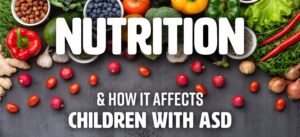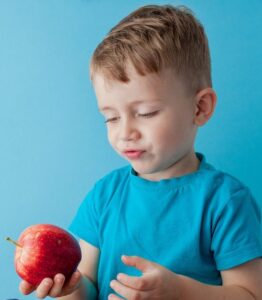
Nutrition is key to a healthy life. There is strong evidence supporting the positive effects of eating a healthy and well-balanced diet consisting of organic foods, fruits, and vegetables. Quality diets also limit processed foods.
Often, individuals with autism spectrum disorder have limited food repertoires, engage in food refusal, or have rigidities about food. This can make eating a healthy and balanced diet difficult and can have negative short-term and long-term effects on an individual’s health.
If an individual engages in any type of food refusal or rigidities, it is important to discuss this concern with a physician prior to beginning any ABA interventions.
In ABA, clinicians are responsible for ruling out anything that is out of their scope of competence. This means that if an individual has a medical diagnosis other than ASD that is associated with food refusals or rigidities, it would be out of the scope of ABA for a clinician to intervene. A competent and well-trained medical practitioner in medical diagnoses would be the most appropriate and ethical referral.
Debunking the Myth About Restrictive Diets and Autism
Restrictive diets have yet to be supported by substantial evidence proving their effectiveness in reducing maladaptive behavior in individuals with autism. This means that restrictive diets are not an effective intervention for anyone who has trouble eating.
Restrictive diets can include casein-free, dairy-free, or gluten-free diets. These diets have not shown any effectiveness in reducing maladaptive behavior in individuals with ASD.
However, ABA interventions have been researched thoroughly for increasing food exposure, decreasing food refusals, and identifying characteristics of food that can be aversive and cause rigidities to form.
Food characteristics that have been identified include texture, brand, color, shape, taste, smell, food being mixed, or food touching. This can look like a child refusing to eat all other yogurts besides a strawberry-banana-flavored one or a child refusing to eat a food altogether because of the texture.
What Can I Do to Increase Exposure to Food Variety?
Research has shown the effectiveness of a few ABA interventions in increasing successful food exposure for individuals with ASD. Some of these strategies include Natural Environment Teaching (NET), differential reinforcement, shaping, using a small set of target foods, and using a hierarchy of food acceptance behaviors.
Exposure can look different depending on the individual. Research has shown that using a hierarchy of food acceptance behavior is a successful way to reinforce and shape food refusal and rigidities.
Natural Environment Teaching (NET) and Nutrition
Increasing food exposure has proven successful when taught in a natural environment. This can vary depending on a family’s eating habits, behaviors, and expectations.
Some families will eat different foods in different locations of the home, while other families may eat their dinner at the same table every evening. These locations are important for targeting food exposure. Providing therapy in a natural environment is a perfect opportunity to reinforce exposure to a new food.
Click here to learn more about Natural Environment Teaching.
Shaping and Differential Reinforcement

Shaping is the process of reinforcing small approximations to a target behavior. In the case of food refusals, our target behavior would be food acceptance.
Differential reinforcement provides more reinforcement for one behavior that is closer to the target behavior. This would look like providing more reinforcement for biting a new food compared to smelling the new food. Both biting the food and smelling the food will be reinforced, but because the biting is closer to the target behavior of food acceptance, more reinforcement would be provided.
Imitation and Peer Modeling
Family habits and eating behaviors can play a helpful role in modeling expected behaviors. If parents would prefer their children to eat what is cooked for dinner, having others model that behavior can be beneficial in food exposure. If a family does not eat a specific food, but that food is selected for food exposure, it may not be as successful if others around are eating a different food.
What Kind of Reinforcement Should Be Provided?
When exposed to new foods, it may take time to learn which food a person prefers. If you find that an individual doesn’t like a certain food, then don’t target it. If someone has tried fish before and has don’t like it, acceptance will probably not happen.
The goal is to expose an individual to foods that are naturally reinforced because they taste good. We can hypothesize that an individual enjoys a certain food if they continue to eat it in the future. Another form of reinforcement that can be very valuable toward food exposure includes verbal praise and social attention.
Further Resources About Autism and Nutrition
Check out more resources about autism and nutrition below!

-
Broccoli Bootcamp – This book is a great resource for parents with children who are selective with food.
-
Example Data Sheet – This printable worksheet lets parents track important food information such as what time of day the meal is given, what food is targeted, and more.
Resources:
Hodges, A., Davis, T., Crandall, M., Phipps, L., and Weston, R. Using Shaping to Increase Foods Consumed by Children With Autism.
Hubbard, Kristie, et al. A Comparison of Food Refusal Related to Characteristics of Food in Children With Autism Spectrum Disorder and Typically Developing Children.
Narzisi, A., Masi, G., and Grossi, E. Nutrition and Autism Spectrum Disorder: Between False Myths and Real Research-Based Opportunities.
Turner, V. R., Ledford, J. R., Lord, A. K., and Harbin, E. R. Response Shaping to Improve Food Acceptance for Children With Autism: Effects of Small and Large Food Sets.




